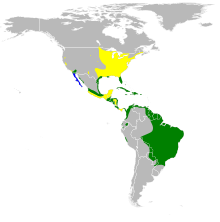American bittern
| American bittern | ||||||||||||
|---|---|---|---|---|---|---|---|---|---|---|---|---|

American bittern |
||||||||||||
| Systematics | ||||||||||||
|
||||||||||||
| Scientific name | ||||||||||||
| Ixobrychus exilis | ||||||||||||
| ( Gmelin , 1789) |
The Least Bittern ( Ixobrychus exilis ) is a bird art from the family of herons .
features
The American bittern is a very small heron with a body length of only about 33 cm. This makes it even smaller than the European bittern . It is light brown with a maroon top. There is a slight sexual dimorphism , as the male is black on the shoulder and upper head, these areas are brown in the females. The young birds resemble the females, but are more striped overall.
Occurrence
The distribution area includes the lowlands of America from Canada to northern Argentina . In the north of its range, it is a migratory bird . The birds that breed there overwinter in Florida or South America . However, stray specimens have also been spotted in Europe . Like most tommels, it lives in dense stocks of reed beds in wetlands.
behavior
It hunts for small fish and insects by climbing in the reed beds . It breeds in reed nests that are well hidden in the reeds. There the female lays four to five eggs . The young birds are raised by their parents together. In favorable years there are occasionally two broods . Because of their hidden life in the reeds, these birds are difficult to observe. If they feel threatened, they usually don't fly away, but just climb deeper into the thicket.
Subspecies
There are six known subspecies:
- I. e. exilis ( Gmelin, JF , 1789) - The nominate form occurs in eastern Canada , the southeast and southwest of the United States .
- I. e. pullus van Rossem , 1930 - This subspecies occurs in northwestern Mexico .
- I. e. erythromelas ( Vieillot , 1817) - This subspecies is distributed in the east of Panama over the north of South America to the north of Bolivia and the north of Argentina .
- I. e. limoncochae Norton, DW , 1965 - This subspecies is found in eastern Ecuador .
- I. e. bogotensis Chapman , 1914 - This subspecies is widespread in central Colombia .
- I. e. peruvianus Bond , 1955 - The range of this subspecies is the western central Peru .
literature
- National Geographic Society: Field Guide to Birds of North America. Washington DC 1999.
- David Sibley: The North American Bird Guide. London 2000.
- Johann Friedrich Gmelin: Systema Naturae per Regna Tria Naturae, Secundum Classes, Ordines, Genera, Species, Cum Characteribus, Differentiis, Synonymis, Locis . tape 1 , no. 2 . Georg Emanuel Beer, Leipzig 1789 ( online [accessed March 25, 2015]).
- Frank Michler Chapman : Diagnoses of apparently new Colombian birds . In: Bulletin of the American Museum of Natural History . tape 33 , no. 12 , 1914, pp. 167–192 (English, online [PDF; 2.7 MB ; accessed on March 21, 2015]).
- James Bond: A New Race of Least Bittern from Peru . In: The Auk . tape 72 , no. 2 , 1955, pp. 208–209 (English, online [PDF; 140 kB ; accessed on March 19, 2015]).
- David Wesley Norton: Notes on some Non-Passerine Birds from Eastern Ecuador . In: Breviora . No. 230 , 1865, pp. 1–11 ( online [accessed March 25, 2015]).
- Adriaan Joseph van Rossem: A new Least Bittern from Sonora . In: Transactions of the San Diego Society of Natural History . tape 6 , no. 15 , 1930, p. 227-228 ( online [accessed March 25, 2015]).
- Louis Pierre Vieillot: Nouveau dictionnaire d'histoire naturelle, appliquée aux arts, à l'agriculture, à l'économie rurale et domestique, à la médecine, etc. Par une société de naturalistes et d'agriculteurs . tape 14 . Deterville, Paris 1817 ( online [accessed March 25, 2015]).
Web links
- Ixobrychus exilis inthe IUCN Red List of Threatened Species 2013.1. Listed by: BirdLife International, 2012. Retrieved September 28, 2013.
- Videos, photos and sound recordings of Ixobrychus exilis in the Internet Bird Collection
- Ixobrychus exilis. (No longer available online.) In: Virtual Bird Guide. Archived from the original on April 29, 2007 ; accessed on February 23, 2013 .
- Ixobrychus exilis. (No longer available online.) In: Pennsylvania Game Commission. Archived from the original on July 9, 2007 ; accessed on February 23, 2013 .
